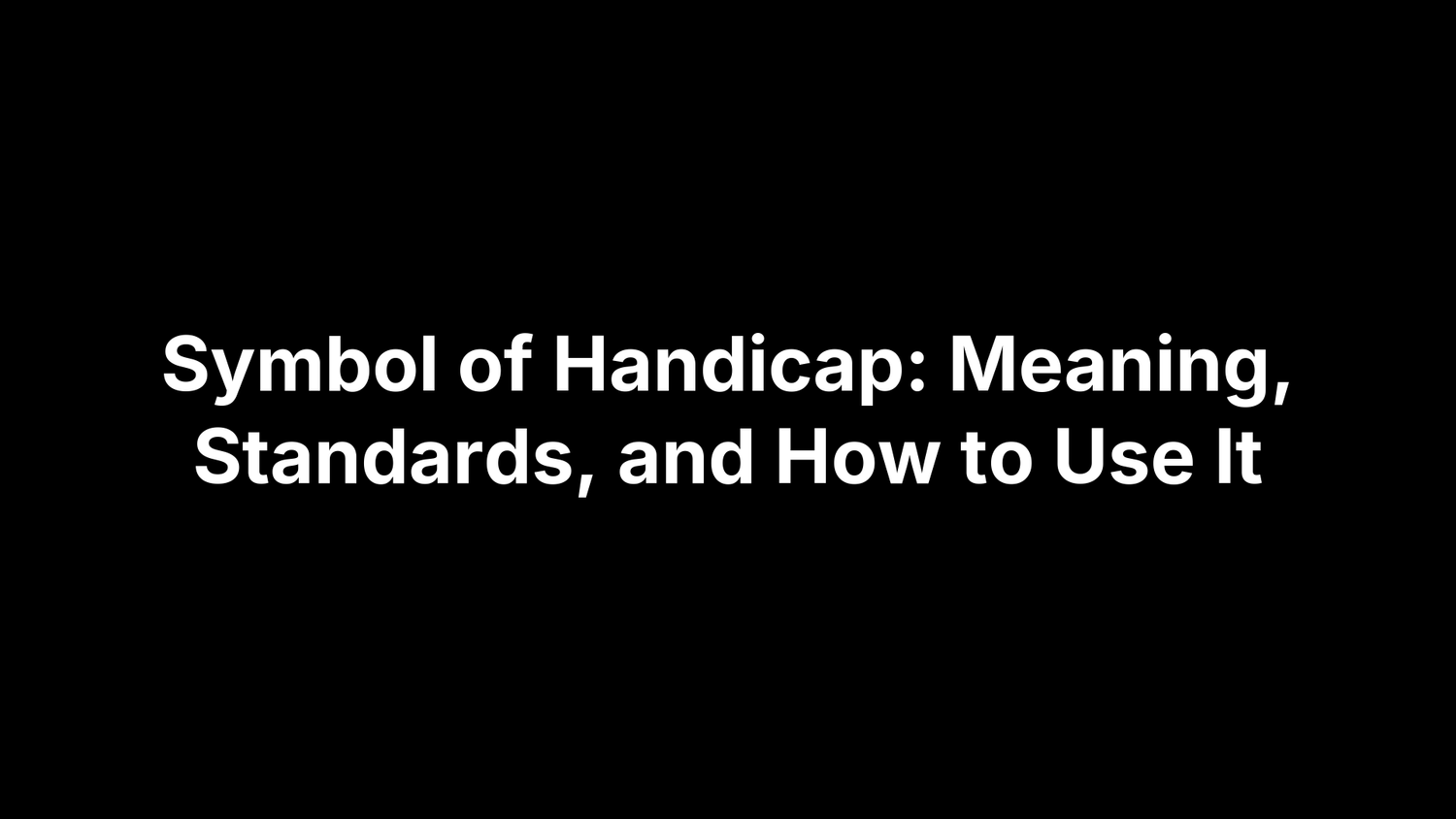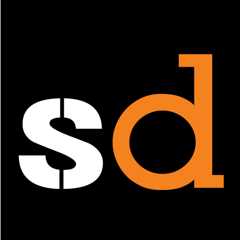Symbol of Handicap: Meaning, Standards, and How to Use It
The symbol of handicap—more accurately, the International Symbol of Access (ISA)—is the familiar white wheelchair figure on a blue field. It signals that a space, service, or route is designed to be accessible to people with mobility disabilities. You’ll see it on parking signs and pavement markings, entrances, restrooms, elevators, seating areas, websites, and wayfinding. While many still call it the “handicap symbol,” its purpose is broader than parking: it’s a universal cue for accessibility that carries legal and design implications.
This guide explains exactly what the ISA means and how to use it correctly. You’ll learn the preferred terminology, where the icon came from, and which standards govern it in the United States (ADA, the U.S. Access Board, and the MUTCD). We’ll cover visual specifications (shape, proportions, colors), clarify the difference between the “Accessible Icon” and the official ISA, and outline where and how the symbol must appear—especially for parking. You’ll also get tips for digital use (emoji, Unicode, alt text), links to compliant downloads, buying advice for durable signs and decals, common mistakes to avoid, related accessibility symbols, a quick implementation checklist, and answers to FAQs.
Terminology matters: “accessible” vs “handicap”
Many people search for the “symbol of handicap,” but the correct term is the International Symbol of Access (ISA). In codes, standards, and professional practice, “accessible” is the preferred, people‑first language. Use it to describe spaces and routes; avoid labeling people or areas as “handicapped.” You’ll also see “Reserved Parking” paired with the wheelchair icon, reflecting this shift. Adopting the right terminology signals respect, reduces confusion, and aligns your signage and decals with modern accessibility guidance.
- Use: Accessible Entrance, Accessible Restroom, Reserved Parking
- Avoid: Handicapped Entrance, Handicapped Restroom, Handicapped Parking
Origins and evolution of the International Symbol of Access
Born in 1968 from a Rehabilitation International call for a universal mark, Danish designer Susanne Koefoed sketched a wheelchair pictogram—the icon many still call the “symbol of handicap.” A circular head was soon added to humanize it, and the white‑on‑blue palette boosted visibility. The International Symbol of Access spread worldwide and, after the ADA, across U.S. sites. In the 2010s, Sara Hendren and Brian Glenney’s “Accessible Icon” offered a forward‑leaning update—shaping debate, though not replacing the ISA nationally.
Current standards and authorities: ADA, the U.S. Access Board, and MUTCD
In the U.S., correct use of the symbol of handicap—the International Symbol of Access (ISA)—is anchored by federal accessibility and traffic-control standards. The Americans with Disabilities Act (ADA) sets the baseline obligation to provide accessible features; the U.S. Access Board publishes technical guidance on where and how the ISA is used; and the MUTCD governs roadway and parking control signs that display the wheelchair symbol.
- ADA/U.S. Access Board: Establish when the ISA must appear (e.g., entrances, restrooms, parking) and reference its recognizable form.
- MUTCD: Controls traffic and parking signage (e.g., D9-6 wheelchair symbol signs) for consistency.
- State/local rules: May add requirements. Note: The U.S. Access Board has not replaced the ISA with the “Accessible Icon,” though some states (New York, Connecticut) permit that variant.
Visual specifications: shape, proportions, colors, and contrast
Visually, the International Symbol of Access—often searched as the symbol of handicap—is a simple wheelchair pictogram presented with high contrast for instant recognition. The canonical treatment is a white icon on a blue field; on roadway and parking signs, MUTCD-compliant panels commonly show a blue wheelchair symbol on a white reflective background (often specified as Traffic Blue on white). Keep the mark clean, legible at distance, and consistent across signs, pavement markings, and decals.
- Keep proportions: Use the standard wheelchair pictogram without stretching, skewing, or rotating.
- Color/contrast: Prefer white-on-blue or blue-on-white with strong contrast; avoid tints, gradients, or low-contrast palettes.
- Clear space: Maintain margin around the icon so it doesn’t crowd borders or text.
- Stroke consistency: Preserve the original line weights; don’t outline or embellish.
- Surface context: For pavement, a white symbol on dark asphalt is typical; for signs/decals, use blue and white with reflective sheeting where required.
The Accessible Icon vs the ISA: what’s allowed where
The forward‑leaning “Accessible Icon” is a redesign of the wheelchair symbol often associated with the symbol of handicap. In the U.S., the official mark for compliance remains the International Symbol of Access (ISA); the U.S. Access Board has not replaced it. Some states, including New York and Connecticut, permit the Accessible Icon in certain contexts, but requirements vary. For traffic and parking control under MUTCD, use the standard ISA.
- Federal and most private sites: Use the ISA to align with ADA guidance.
- State/local allowances: Verify statutes before swapping to the Accessible Icon.
- Parking/pavement: Default to the ISA unless your DOT specifies otherwise.
Where the symbol is required: buildings, programs, and wayfinding
Beyond parking, the symbol of handicap—the International Symbol of Access (ISA)—identifies accessible features and directs people along accessible routes. Use it wherever accessibility isn’t obvious or when only some options are accessible. This includes building entries, interior circulation, services, and temporary conditions so visitors can find the compliant route, space, or facility without guesswork.
- Building entrances/exits: If not all are accessible, mark the accessible entrance and place ISA directional signs at inaccessible doors.
- Interior routes: Identify accessible routes to elevators, ramps, and platform lifts wherever stairs appear.
- Facilities and services: Mark accessible restrooms, drinking fountains, service/ticket counters, and passenger loading zones that meet requirements.
- Assembly areas: Label accessible seating locations and companion seating.
- Wayfinding and maps: Show the ISA on directories, floor plans, and event signage.
- Temporary conditions: Use portable ISA signs for detours, construction, and accessible portable restrooms.
Parking requirements at a glance: spaces, aisles, signs, and markings
Accessible parking succeeds when drivers instantly recognize what’s reserved, where the access aisle is, and how to reach the accessible route. Use the International Symbol of Access—the symbol of handicap—in both signage and pavement markings, and align with ADA guidance and MUTCD rules for traffic‑control signs to ensure consistency, visibility, and enforceability.
- Spaces and aisles: Provide a clearly striped no‑parking access aisle adjacent to each accessible space and connect it to the accessible route.
- Upright signs: Post a permanent sign with the ISA; add “Van Accessible” where applicable.
- Reflectivity: For roadway/lot signs, use MUTCD‑compliant reflective sheeting (e.g., blue wheelchair on white).
- Pavement markings: Stencil the ISA with strong contrast; maintain legibility over time.
- Placement: Locate spaces on the accessible path to entrances; keep aisles unobstructed year‑round.
Digital use: emoji, Unicode, alt text, and accessibility best practices
Online, the symbol of handicap appears as the wheelchair symbol emoji ♿ and as UI icons. Its Unicode code point is U+267F (Wheelchair Symbol), approved in Unicode 4.1 (2005) and added to Emoji 1.0 (2015). Use the icon to indicate accessible features, and always support it with clear text and accessible names.
-
Emoji/Unicode: Use ♿ (
U+267F) as a supplementary cue—never the only signal of accessibility. - Alt text/names: Prefer people‑first labels like “Accessible entrance” or “Accessible parking,” not “handicapped.”
-
ARIA usage: If the icon conveys meaning, provide an accessible name:
<svg role="img" aria-label="Accessible parking">…</svg>; if decorative, hide it:<svg aria-hidden="true">…</svg>. - Contrast and context: Keep icons high‑contrast and large enough to recognize; don’t rely on color alone—pair with visible text.
Downloading and licensing the icon: where to get compliant files
To use the symbol of handicap correctly, source a standard, unaltered International Symbol of Access (ISA) in vector format. Reliable options include the ISA SVG on Wikipedia, the free AI/EPS/JPG set from the Graphic Artists Guild Foundation, and licensed vectors from Adobe Stock or iStock. For MUTCD parking signs, use DOT/vendor‑supplied artwork. Always review licenses and preserve proportions, color, and contrast.
Buying compliant signs and decals: materials, reflectivity, and durability
When you buy signage or decals that display the symbol of handicap—the International Symbol of Access—choose constructions that stay legible, enforceable, and weather‑tough. For outdoor parking and wayfinding, match MUTCD‑style conventions so first responders, inspectors, and drivers recognize the message instantly, day or night. Reflectivity, substrate thickness, ink durability, and proper color treatment (blue wheelchair on white or white on blue) are what keep the icon compliant and visible.
- Parking signs: .080" aluminum, High‑Intensity Prismatic (HIP) reflective sheeting, Traffic Blue on white, 1.5" radius corners, pre‑drilled mounting holes.
- Facility decals: Premium vinyl (e.g., ORAFOL), permanent adhesive, UV‑stable inks, clear overlaminate for abrasion and cleaning resistance.
- Reflectivity: Use reflective sheeting for exterior signs so the ISA is readable at night and in poor weather.
- Color fidelity: Keep the standard wheelchair blue and strong contrast; avoid tints, fades, or outlines that reduce clarity.
Common mistakes to avoid and how to fix them
Most missteps with the symbol of handicap—the International Symbol of Access (ISA)—come down to clarity, contrast, and context. Stick to standard artwork, MUTCD‑style signs, and people‑first wording to stay compliant.
- Using “Handicapped” wording: Say “Accessible” and pair with the ISA.
- Accessible Icon where not allowed: Use the ISA unless state‑approved.
- Visual alterations (low contrast, color drift, distortion): Keep white‑on‑blue or blue‑on‑white and standard proportions.
- Pavement mark without a sign: Add a reflective ISA sign; add “Van Accessible” when required.
- Labeling noncompliant features: Don’t use the wheelchair symbol unless the space, aisle, and route comply and stay clear.
Related accessibility symbols you should know
The wheelchair pictogram isn’t the only accessibility cue you’ll need. Pair the symbol of handicap (the ISA) with other standardized icons so people can locate the right format, service, or route—especially when only some options are accessible. Consistent use improves wayfinding and supports compliance.
- Braille: Identifies Braille versions of signs or materials.
- Closed/Open Captioning (CC/OC): Captions provided for media.
- Assistive Listening Systems: Loop, FM, or IR amplification available.
- Sign Language Interpretation: Interpreter present for programs/events.
Quick implementation checklist for businesses
Use this quick checklist to deploy compliant signage and decals featuring the International Symbol of Access—the symbol of handicap—across facilities and parking. Focus on clarity, contrast, and enforceability to align with ADA/U.S. Access Board intent and MUTCD conventions.
- Artwork: Standard ISA; no alterations.
- Language: Use “Accessible,” not “Handicapped.”
- Signs: Reflective upright ISA; add “Van Accessible.”
- Pavement: High‑contrast stencil; stripe access aisle.
- Placement/Maintenance: Nearest accessible route; keep clear, audit.
FAQs about the wheelchair symbol
Below are concise answers to the questions teams ask most when specifying the International Symbol of Access—the symbol of handicap—on signs, decals, and digital interfaces. Use these as a quick reference to stay consistent with ADA intent, U.S. Access Board guidance, and MUTCD conventions for parking control.
- What does ♿ mean? It’s the Unicode Wheelchair Symbol emoji used to indicate accessibility.
- Is the “Accessible Icon” official? Federally, no—the ISA remains standard; some states (e.g., NY, CT) permit the variant.
-
How do I type it? Use Unicode
U+267For copy/paste ♿. - Which colors are correct? White-on-blue or blue-on-white with strong contrast; reflective for parking signs.
- Where can I get artwork? Use standard ISA vectors from neutral sources (e.g., Wikipedia, Graphic Artists Guild) and keep proportions unchanged.
Key takeaways
The wheelchair pictogram (International Symbol of Access) is the universal marker for accessibility. Use people-first language, follow ADA/U.S. Access Board intent and MUTCD for parking, preserve contrast and proportions, and confirm any state rules before adopting variants. For compliant, durable signs and decals, visit Safety Decals.
- Use the standard ISA artwork.
- Mark only truly accessible features.
- Pair pavement stencils with upright signs.
- Maintain clear, striped access aisles.


